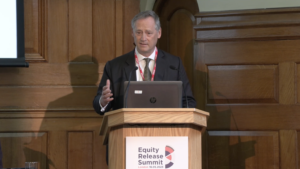UK Equity Release Summit focuses on route map for later life lending

The potential role of the UK’s £5 trillion property wealth in addressing major societal challenges facing the UK’s ageing population was the subject of a recent report commissioned by the Equity Release Council, entitled ‘Later Life Lending: Great Expectations’. The recommendations of this report were explored in a plenary session at the UK’s Equity Release Summit on 16 May.
This independent report was commissioned by the Equity Release Council earlier this year, and was published by Jon Dunckley, CEO of About Consulting Group. It was commissioned to help set out a route map for all market participants – including government, regulators, and industry – to better support the UK’s ageing population.
The report calls for coordinated action to build on recent progress to create a later life lending market which reflects consumers’ evolving needs and can support a joined-up approach to using property wealth in later life financial planning. The ultimate aim is to raise retirement living standards and equip homeowners and their families to enjoy a better quality of life.
The session was introduced by Jim Boyd, Chief Executive Officer, Equity Release Council, who explained why the report had been commissioned, and was followed by a panel chaired by Tom McPhail, Director of Public Affairs at the lang cat. The findings were discussed by a number of expert panellists, namely Jon Dunckley, CEO, About Consulting Group; Paul Broadhead, Head of Mortgages and Housing, The Building Societies Association (BSA); John Somerville, Head of Financial Services, Corporate & Professional Learning, The London Institute of Banking & Finance (LIBF) and Charlotte Allen, Chief Compliance and Risk Officer, Key Group.
The future of retirement will have to change
Introducing the session, Jim Boyd noted that in 10 years’ time one quarter of the UK’s population would be 65 or older, and that “the future of retirement will have to change” as there would be fewer working people to support an increasing share of public spending on older people.
He mentioned that he had attended a “brilliant meeting” of EPPARG members the previous evening, which brought together market players from the US, Canada, Australia and Europe, and highlighted that “the commonality of issues is what stood out. There is nothing new here. This is a global issue for advanced economies”. He asserted that “unlocking the huge reservoir of property wealth” might not be the whole solution but it would play an important part.

He highlighted that UK net property wealth is worth £5.6 trillion pounds, representing approximately £228,000 per household, and that according to Savills, over 50s own 78% of the UK’s housing stock.
In terms of equity release, since 1991, 640,000 homeowners had accessed £45 billion from Equity Release Council members, and last year the average equity release plan was worth £133,000. He saw that this could close the gap from a minimum pension for around 18 years of a moderate lifestyle. He also noted how equity release could support women, who tend to have the worst pensions, live longer by themselves and who are the least likely group of people to shop around for alternative assets. He explained that a quarter of all equity release plans taken out provide some sort of living inheritance for the next generation, which can help them to get on the housing ladder and also to support environmental improvements.
Considering that the contribution of equity release to the UK economy is “clearly significant”, Jim asked “why is it not achieving its potential?” In his view, the regulatory framework is disjointed, with mortgages and equity release subject to different regulations, with too many advisers working in silos. He saw that the UK had a department of work and pensions, but not a department of work and retirement. “If you can’t align the objectives with government in a coherent way it is impossible that those broader conversations can be understood at a higher level,” Jim underlined.
Since property – which is the biggest asset for most people – is not included, Jim urged that the government and industry should “work together to collectively agree a blueprint for the use of what housing wealth looks like in later life” and explained that this was why they had commissioned an independent report from Jon. “Every time I read about a pensioner with a house of about 300k unmortgages, struggling to make choices between heating and eating, and they haven’t considered the option of housing wealth …. I treat it as a failure,” Jim concluded.
Finding the right solutions for later life lending
The discussion was led by Tom McPhail, who noted the people who were expecting an inheritance were now mainly in their 50s and asked if that was the best point in life to receive the money. He saw that equity release could fix more problems for people and saw that there was an opportunity to stimulate economic growth. He saw that despite product innovation and standards, “we are not making a lot of headway” since it had not changed the game yet. He emphasised that “most people still have a fairly negative perception of the equity release sector” and saw that there was a gap between equity release advice and wealth management advice more broadly.

As the author of the report, Jon Dunckley, stressed the need to come up with a political consensus on the way ahead. He highlighted that the UK has got an extremely adversarial political system where “an opposition that agrees with government policy is seen as weak”. He saw that without a political consensus, “no one has the bravery to face into the really difficult challenges that we have got as a country with a policy that might have a chance of resolving it”. He described the care system in the country as “broken”, where there should be an option of making it easier for people to take care of themselves. Overall, he saw that a consensus could only be built if there was a will and support of leadership and ideas.
Paul Broadhead saw that the challenges had now evolved. He considered that for government it is easier for industry collectively to start to have discussions “rather than asking government to decide our future”. He thought there was a need to ensure people are getting the right financial solution for their circumstances at the right time. He also underlined that the mainstream and lifetime markets operate in isolation and are subject to different regulations.

John Somerville remarked that “there is an awful lot of education needs to happen in order for us to move forward” and saw that the shortage of housing was an issue. He advocated that “we have got to stop sitting in silos” and considered that “wealth advisers don’t care that much and equity release advisers need to get their point across”. He urged that the industry to “create a need that wealth advisers can’t walk past” as they could refer the customers. “If you are not talking to wealth advisers in your locality it is about educating each other,” he summed up.
Elaborating on the point of referrals, Charlotte Allen noted that the regulators were doing a lot of work on the sector and saw that “if a customer can afford to make the payments then equity release might not be the right thing”. She saw that there was a need to have referral networks to other partners where a different type of advice was needed.

The report “Later Life Lending: Great Expectations” can be accessed here.